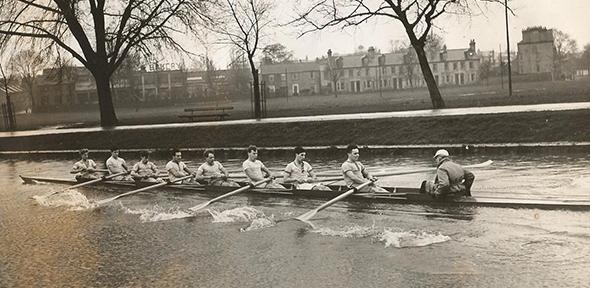
’99 Rowing Club Captain, Keith Garrett, told Open Cambridge a little about the history of rowing in Cambridge and what visitors can expect from the drop-in event, The Cambridge Boathouses, on Saturday 12 September.
OC: What does your role entail with the rowing club?
KG: Keeping everything running and ensuring that all our different squads work well together to get the most out of their rowing and the club. I also look at club development and the outward image of the club.
OC: What’s it like taking part in the bumps?
KG: The Bumps are one of the most exciting races you can be in. The tension that begins to build as you leave the boathouse reaches a crescendo once the cannons start going off at the start. The intensity is only matched by the comradeship you have with your fellow crew members who you have trained and raced with. And the sense of accomplishment, exhaustion and completion as you get a bump is overwhelming. Competing as a club, you share in the victories of the other crews.
OC: Can you give us a brief history of rowing in Cambridge? How did the bumps start?
KG: In the 1700s the River Cam was choked with mud and rushes and virtually dry in summer. The only recreational boats were canoes and small boats – owned by local boat-builders – that were let out for picnics, etc, much as the punts are now.
Formal college rowing in eights started in 1825, although the river was in a bad state and boats often became grounded or tied up in the weeds. Two years later, organised bumping races started between the colleges as the river was (and remains) too narrow for side-by-side racing. Locks built along the river improved access for barges and helped rowing take off as a sport.
Racing between Town and College clubs started in 1843 (Cambridge Town Club vs the Vulture Club) and the first Town Bumps were held in 1868.
OC: And what about the boathouses? Which was the first to be built?
KG: The Cambridge University Boat Club Goldie boathouse is the oldest surviving boathouse on the Cam and was built in 1882. However, the first college boathouse to be built was Trinity in 1872 (rebuilt in 1896). The Cambridge ’99 Rowing Club boathouse (named because it was founded in 1899) burned down in 1983 and replaced with our current modern building.
OC: What can people expect from the tour?
KG: There will be opportunities for visitors to try rowing on the river in our affectionately named “tub” or check their technique on our erg machines. They can talk to club members to discover more about the sport of rowing and the benefits of exercise supported by a club environment. There will also be a tour of the boathouses along the Cam.

